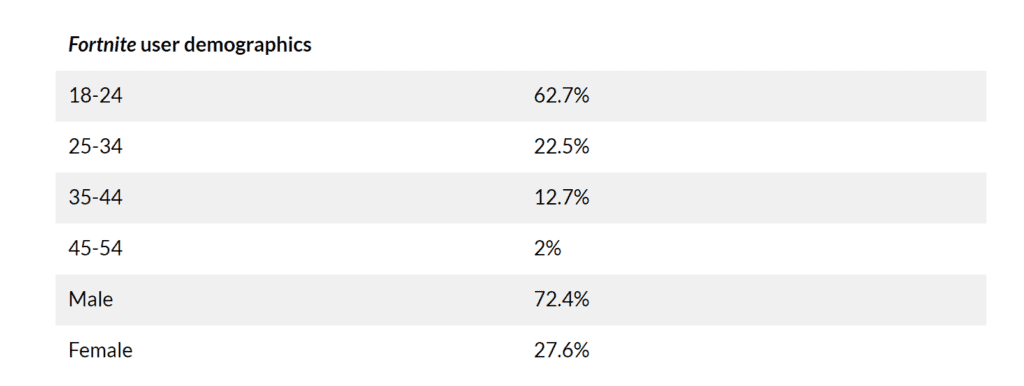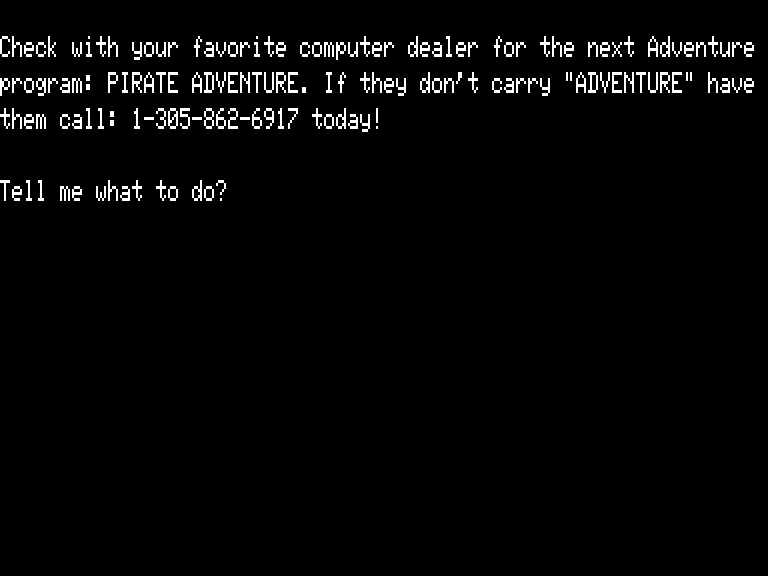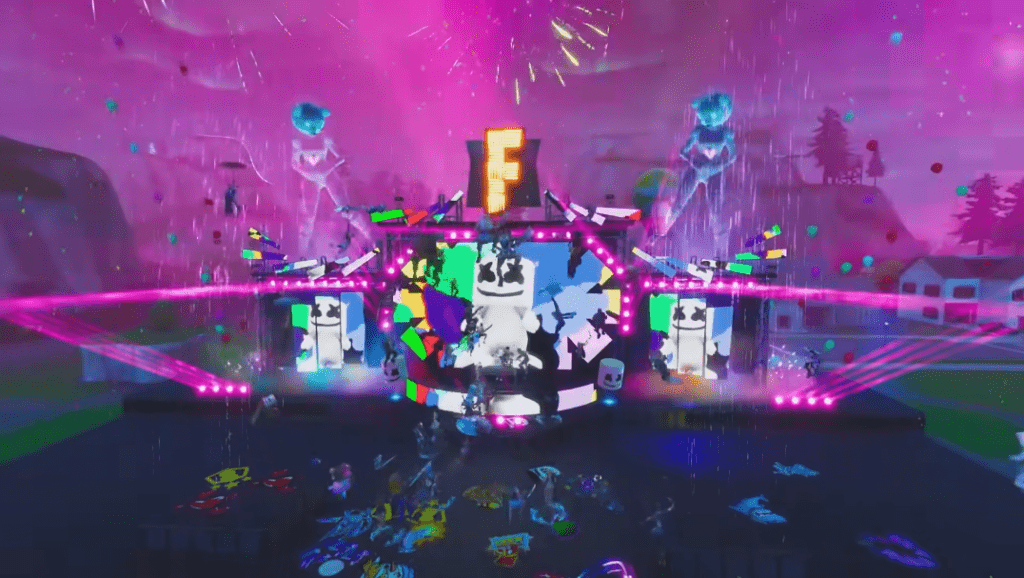Should You Buy Ads on Fortnite?

Where we droppin’, boys?
When it comes to your mobile advertisements, it seems that the resounding answer is right in the middle of Fortnite. This obscenely popular game has been around since 2017, pulling in more than 125 million players in its first year, and still holding strong at over 350 million players as of May 2020.
With releases across just about any console or device you could imagine, including Windows, MacOS, PlayStation 4, Xbox One, Switch, Android, and iOS (though it was removed from the last two in August of 2020), it’s hard to deny that this cultural phenomenon resonates with a wide swath of valuable advertising demographics. In fact, brands like Wendy’s, Marvel, and the NBA have been milked this cash cow to the tune of $1.8 billion in revenue in 2019.

So, what is it about this battle royale shoot-’em-up that keeps big brands spending money and players accepting– even celebrating– advertisements? Clever integration.
A Brief History of In-Game Marketing
The relationship between marketing and gaming is nothing new. Since the beginning, video game publishers have made it a priority to push revenue through sponsorships, product placement, and flagrant self-promotion.
It should come as no surprise that retro ads, in all their bizarre glory, started some of the most common marketing tactics we see in use today.
All the way back in 1978, a game called Adventureland, published by Creative Computing Software and Adventure International, contained an advertisement for their next game, Pirate Adventure.

These humble beginnings opened the proverbial floodgates for IGA (in-game advertising). Some examples have been a rousing success, like McDonald’s sponsoring of PokeStops in Pokemon Go or Mercedes-Benz placement in Mario Kart 8. On the other end of the spectrum, NBA 2K created quite the backlash after placing unskippable advertisements in their $60, triple-A title that was already chock full of microtransactions.
Following the outrage, the game company released an official statement that read: “As many are aware, in recent years ads have been integrated into 2KTV segments. Yesterday’s 2KTV ad placement impacted our players’ experience in a way we didn’t intend, as these ads are not meant to run as part of the pre-game introduction. This will be fixed in future episodes. Thanks for your continued feedback.” Basically, 2K was not committing to removing the ads… Only adjusting their placement.
Similarly, EA Sports pulled a similar move with their UFC 4 title. The criticism sparked EA to completely disable the integration and to issue their own apology:
“We realize that this should have been communicated with players ahead of time and that’s on us. We want to make sure our players have the best possible experience playing EA SPORTS UFC 4, so ad integration in the Replay and overlay experience will not be reappearing in the future.”
Despite these misfires, IGA is nothing to scoff at. In 2019, $11.82 billion was spent on mobile games, with revenue rising 24% year-over-year.
Big Brands Find Their Footing in Fortnite
We mentioned earlier that most of Fortnite’s advertising success comes from clever integration. Even in its mobile iterations, Fortnite never intruded on playtime with pop-up video ads urging you to download a different app or check out a brand new flavor of Mountain Dew. Instead, they coax their players to special events, screenings, and game modes that feature whatever brand has paid for the honor.
One of the first big examples of the power Fortnite has over marketing was the 2019 Super Bowl weekend in-game dance party, hosted by DJ Marshmello. Around 10.7 million players were in attendance, along with the innumerable folks who livestreamed it on Twitch. The day after the event, nearly 700,000 new subscribers made their way to DJ Marshmello’s YouTube channel, along with a jump from 7.8 million to 42.8 million views per day. It’s also interesting to note that two weeks later, on February 16, 2019, Fortnite broke their record for the most players online concurrently, at 7.6 milli0n.

Wendy’s took a sip from the Chug Jug in November of 2018 after the introduction of Food Fight Mode, an in-game event that pitted Team Burger against Team Pizza. When the game mode was introduced, Wendy’s noticed that Team Burger used freezers in their restaurants. Of course, this is considered a mortal sin in the eyes of our square-pattied friends, so they took to Twitch, where they livedstreamed in a custom character skin that resembled as certain red pig-tailed mascot. She jumped into action, destroying freezers across the game environment, with the community joining in on the fun. As the perfect finishing touch, Fortnite went on to remove the freezers from the game. The 10-hour stream brought the fast food chain 7,400 new followers on Twitch, 1.5 million total minutes of video watched, and 43,500 comments.
In our last example, Michael Jordan’s Jumpman brand came to Downtown Drop Mode. Instead of basketball, the focus was on skateboarding. Players rolled around in a Brooklyn-inspired environment to pickup limited-time loot and complete challenges that included prizes like the Back Board backpack item. In addition to the free gear, Fortnite also offered a “Hang Time Bundle” for 1,800 V-Bucks, the equivalent of $18 USD. It included two outfits with customizable Air Jordan sneakers.
Obviously, this symbiotic relationship between brands popular with 18-24 year old males and the game they love is an effective one. Brands get the consumer attention they’re looking for, Fortnite sells exclusive loot, everyone’s happy.
But, the question remains… Should you buy ads on Fortnite?
For Smaller Brands, Fortnite Advertising Might Be an Overreach
While it’s great for the players that Fortnite avoids intrusive advertisements, it’s not good news for smaller brands. The game has the social clout to work with big names on expansive collaboration projects, leaving businesses without multi-million dollar advertising budgets out of the loop… at least for now. But, that doesn’t mean that you can’t take the ideas behind Fortnite’s innovative marketing strategy and apply it to your own brand.
One good place to start is Twitch. We’ve talked about the potential for marketing on the popular streaming platform previously, and our sentiments on the topic hold true:
“Twitch is an extremely social platform, with multiple ways for viewers and creators to connect, and it’s this personal engagement that brings people back to their favorites broadcasters. Creators narrate, and crack jokes live as they play their games. This adds a level personalization that can make every player’s channel vastly different, even when they’re playing the same game.
And it’s this layer that distinguishes influencers from lower level creators. These players are charismatic and funny. They engage, not just with the game they’re playing, but with their viewers. It’s a conversation. If you can get yourself placed into this conversation, get the right influencers talking about your brand, you can build a level of engagement with your target audience that is, in some ways, unparalleled in the marketing world.”
Whether you’re ready to dip your toe or dive in when it comes to IGA, let NATIV3 be your guide. We’ve helped dozens of clients find their niche in the vast landscape of digital marketing, and we’d love to help you too.